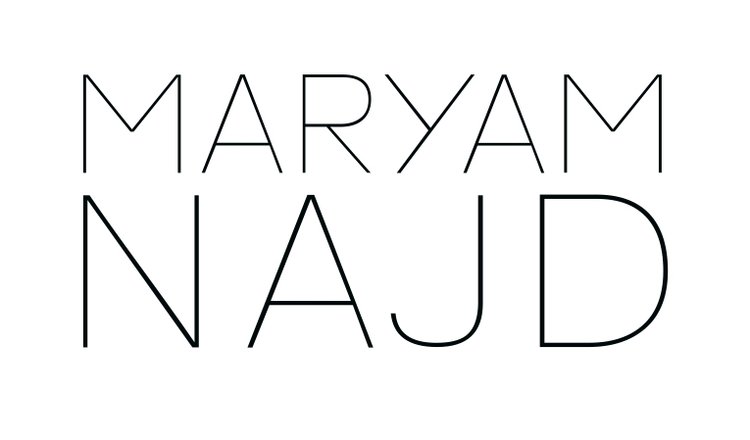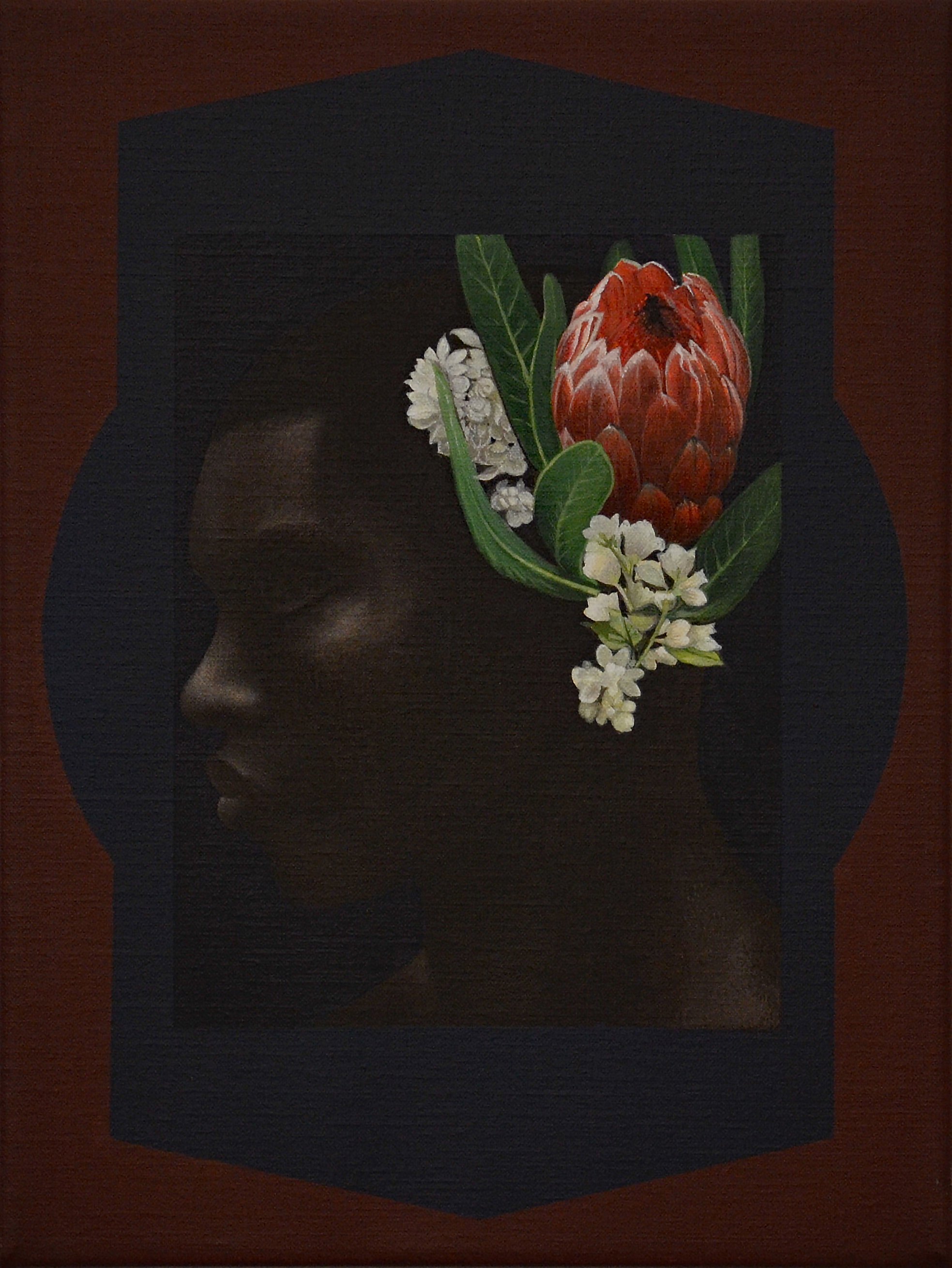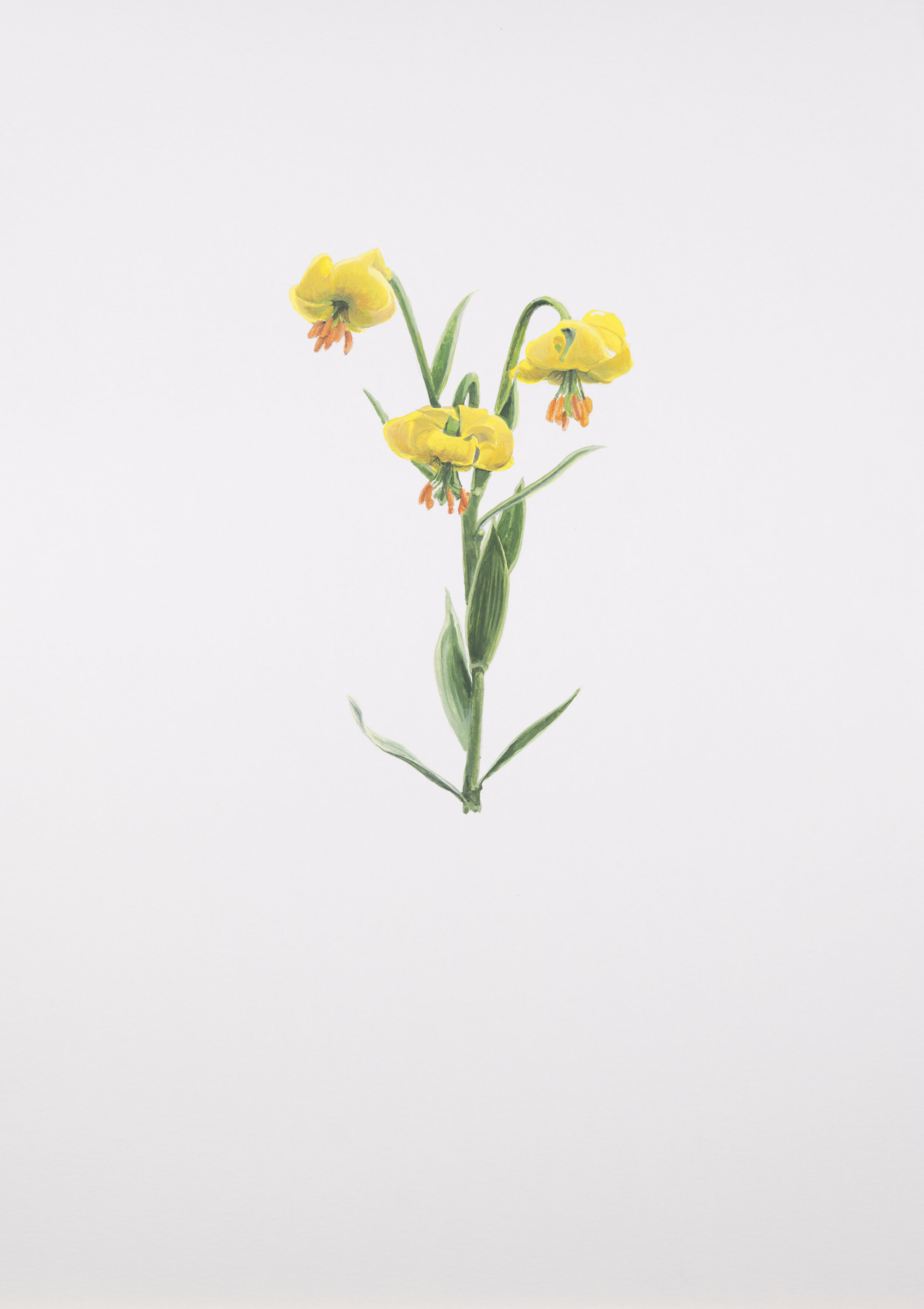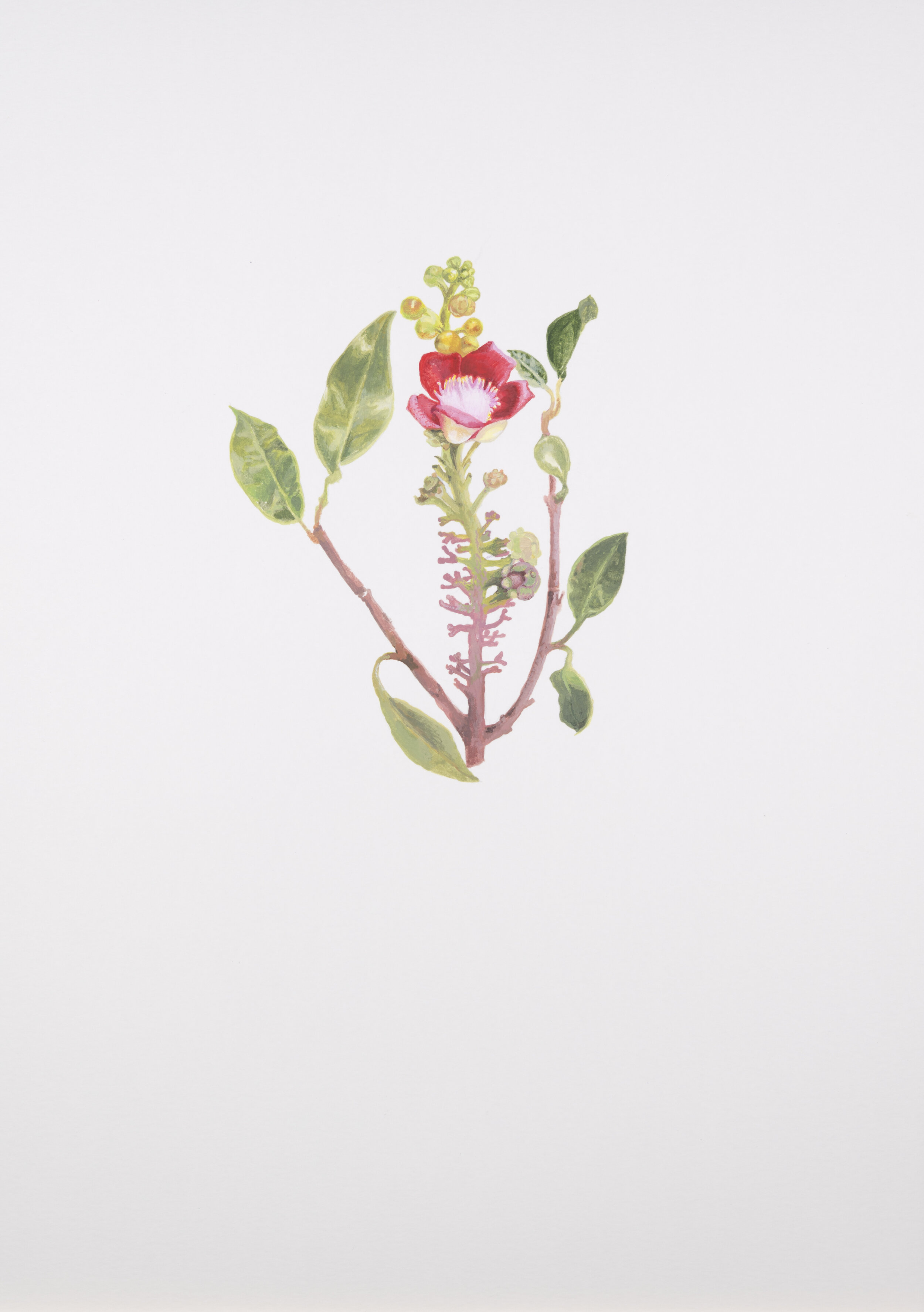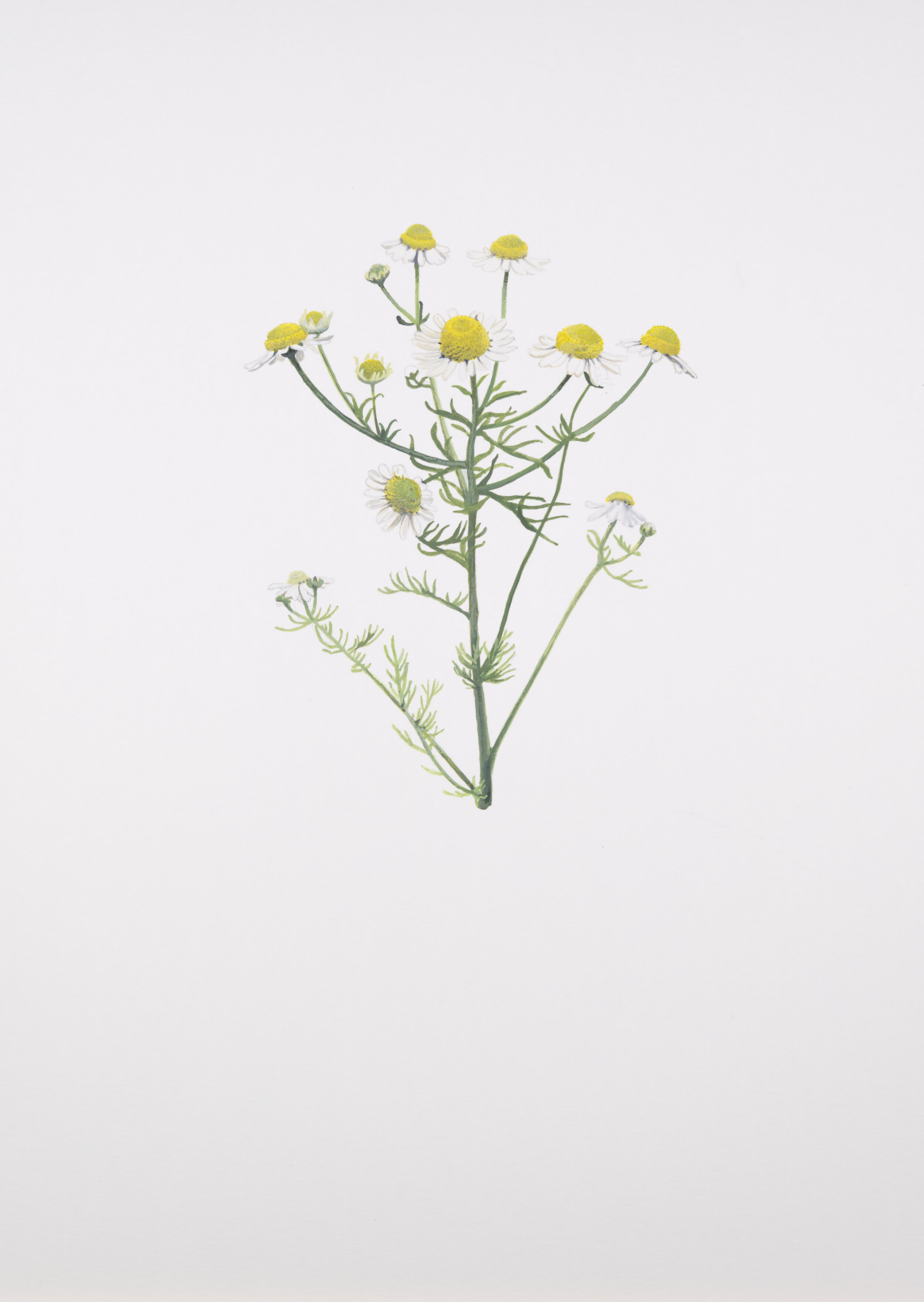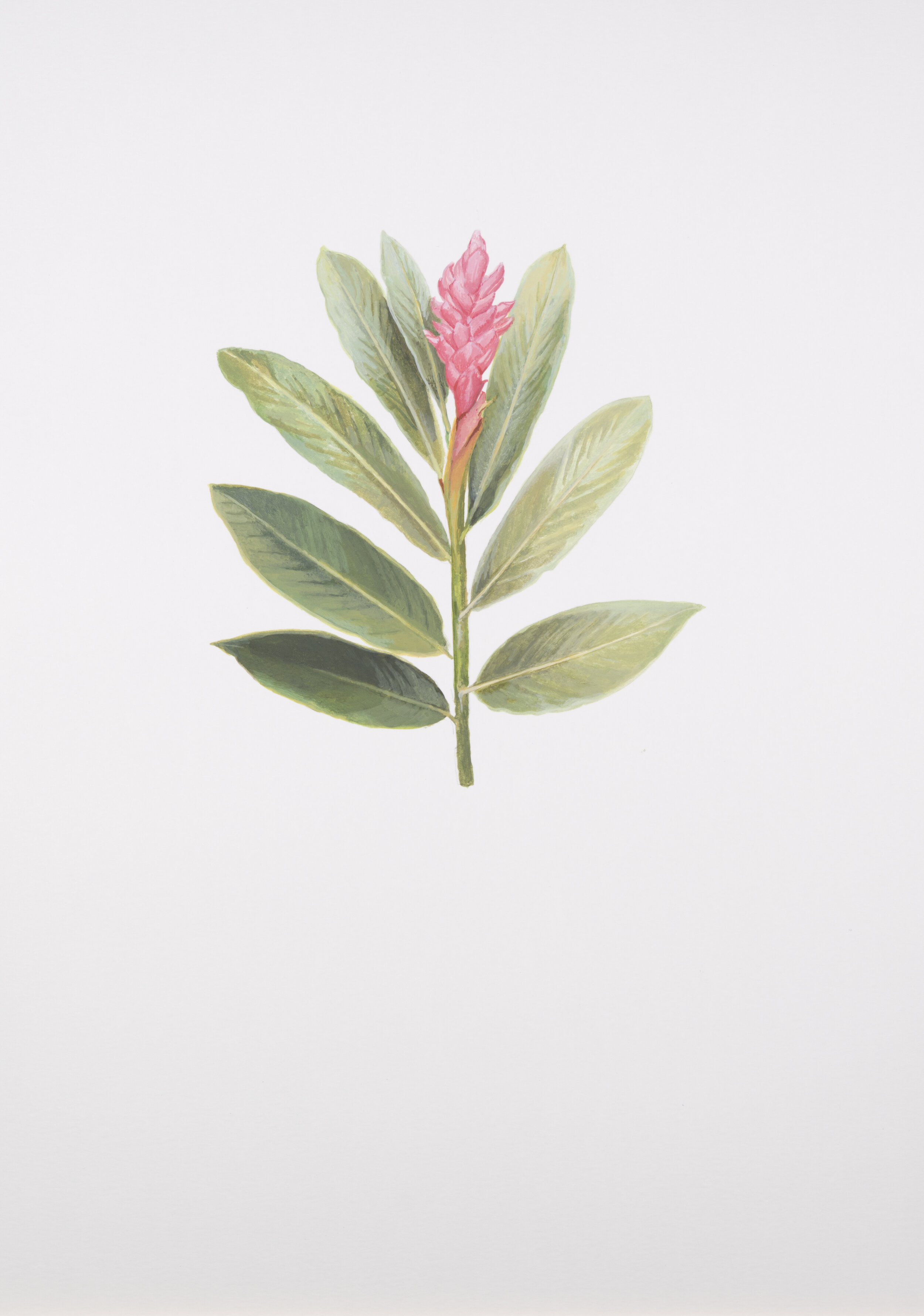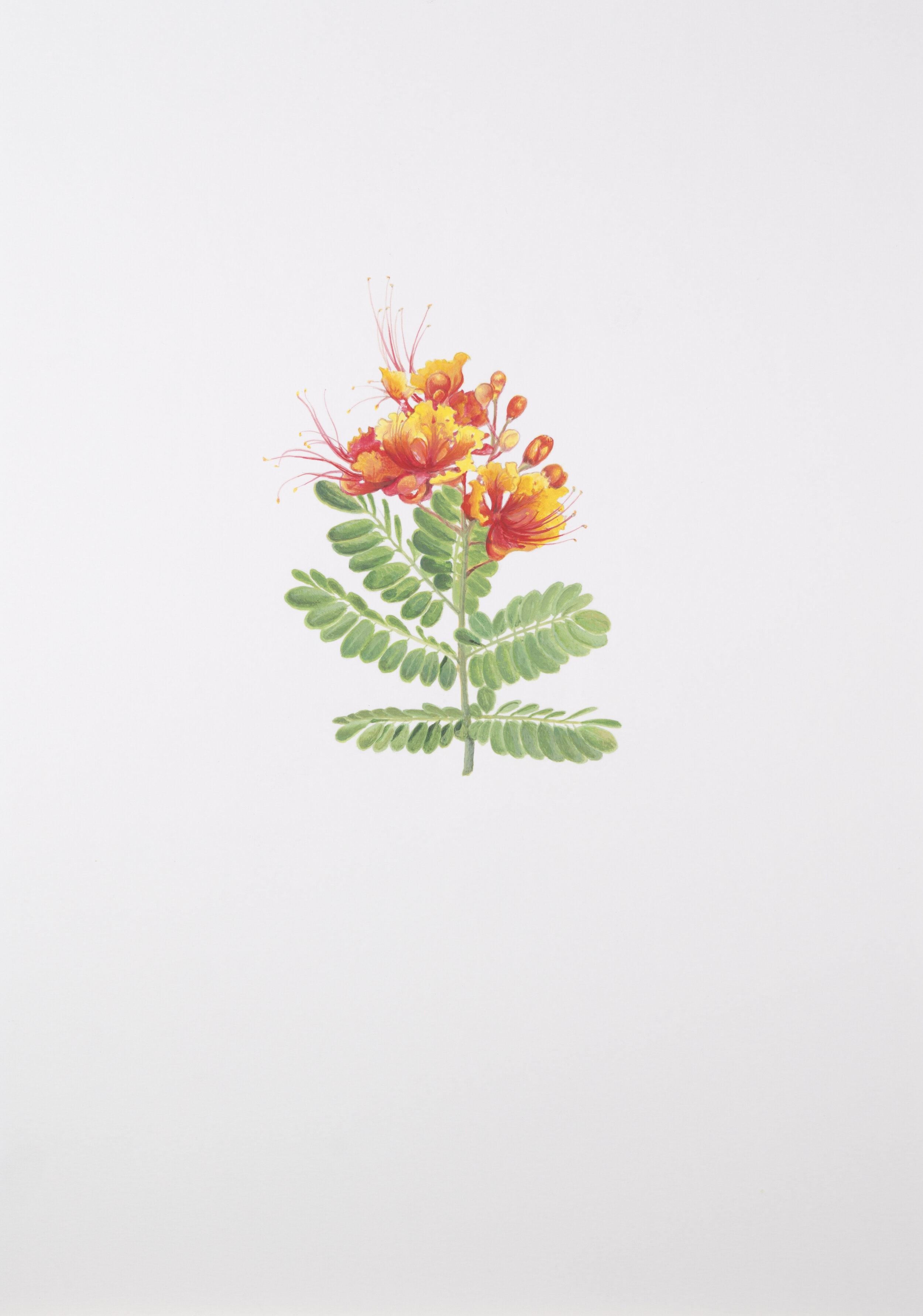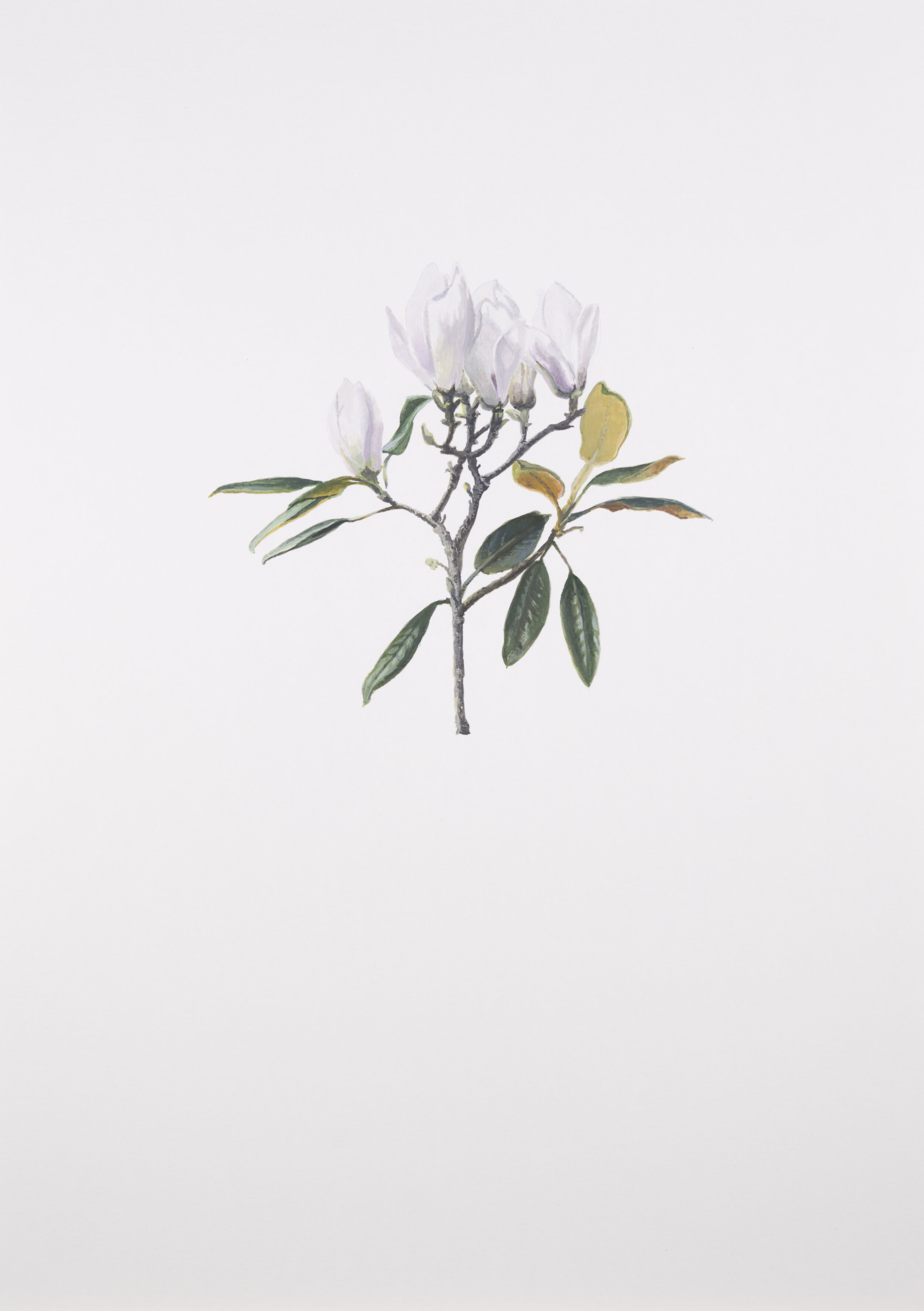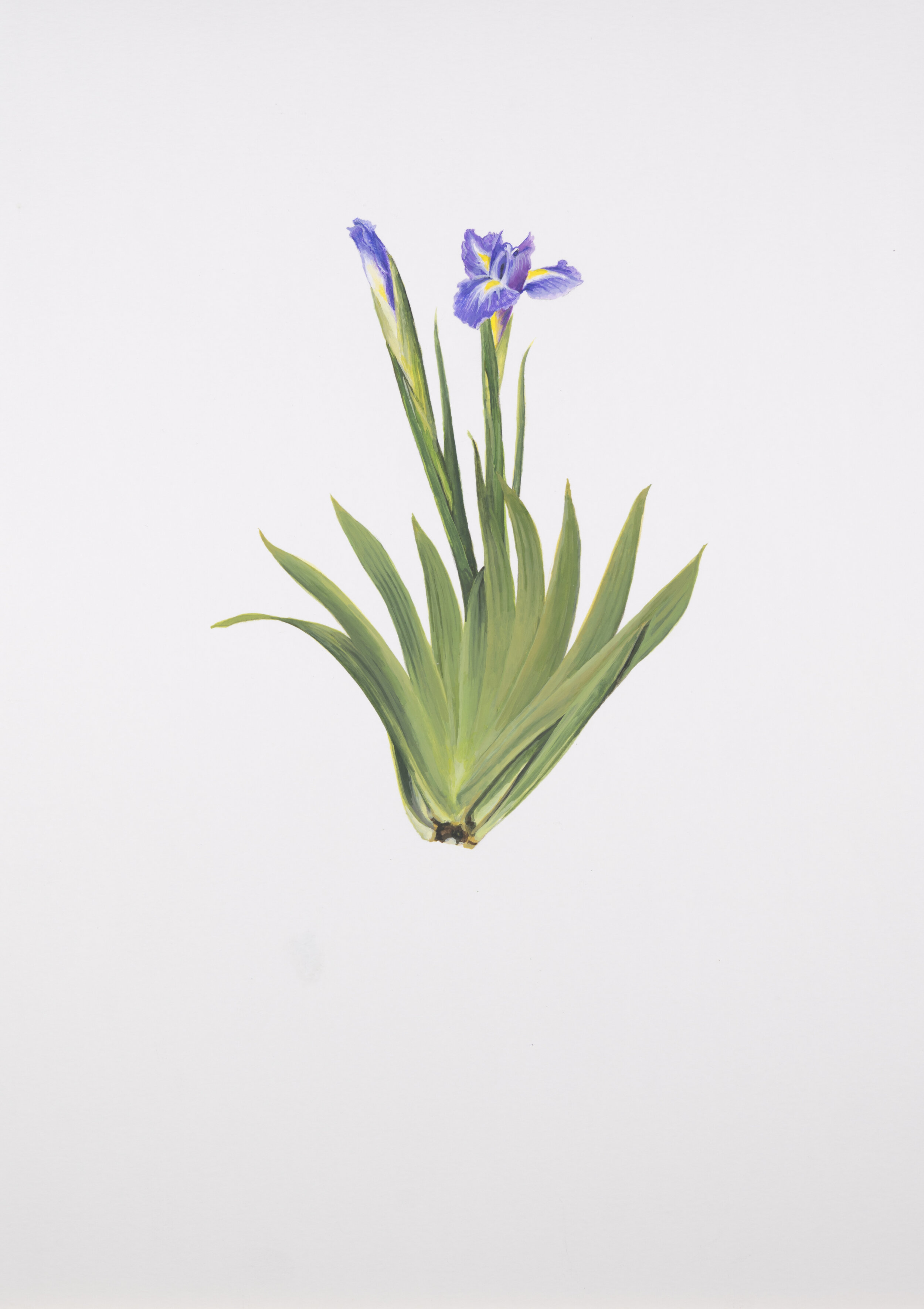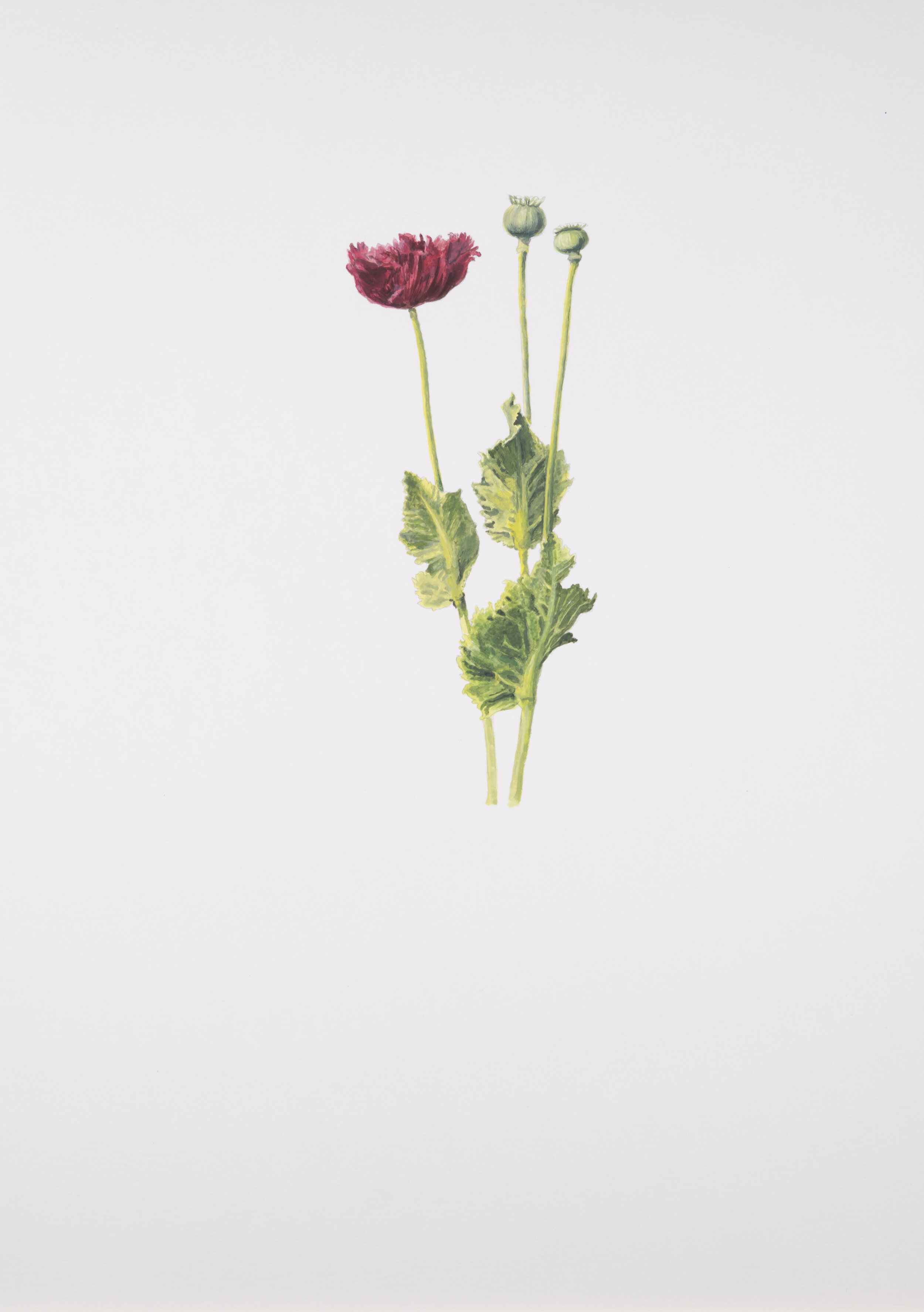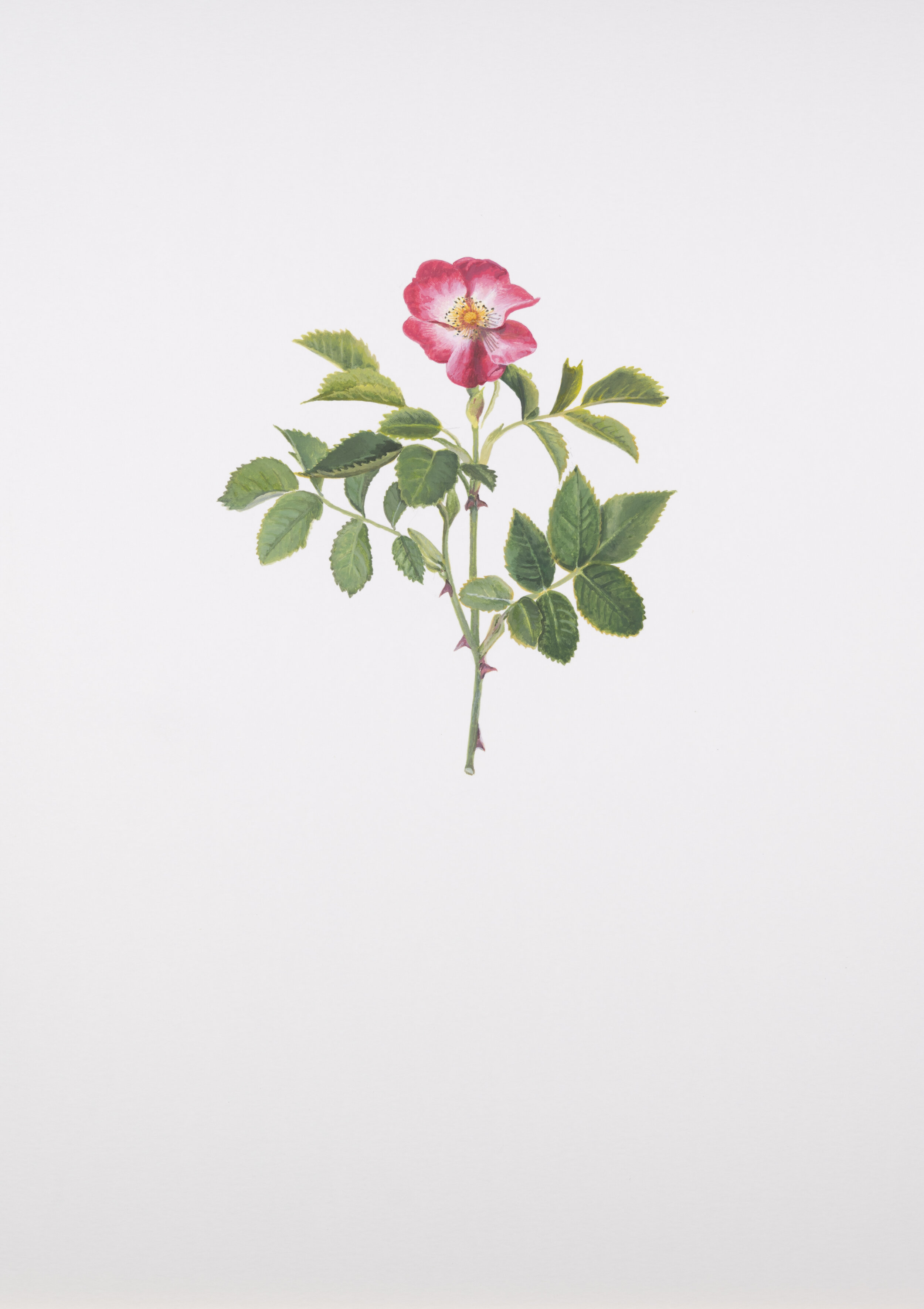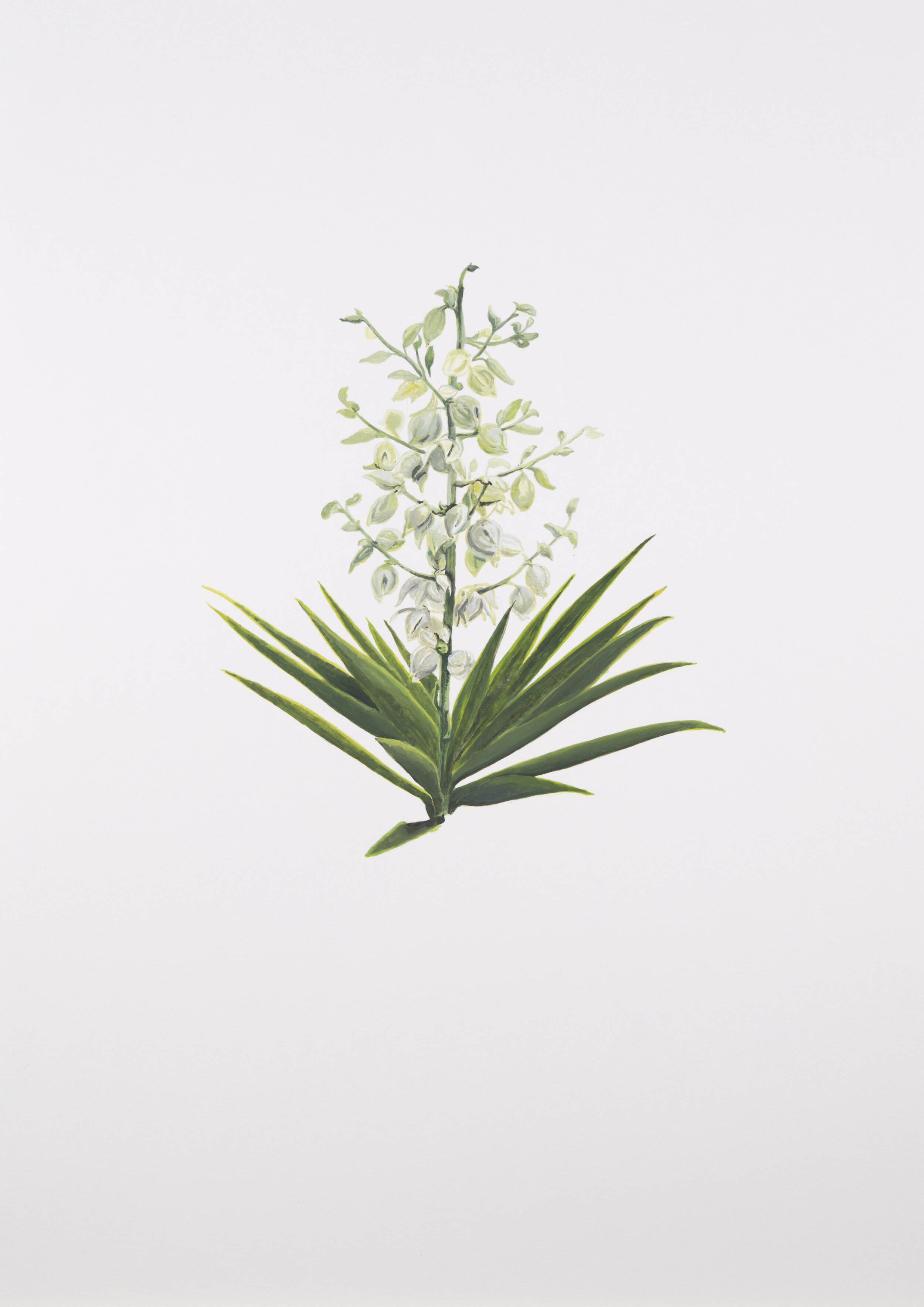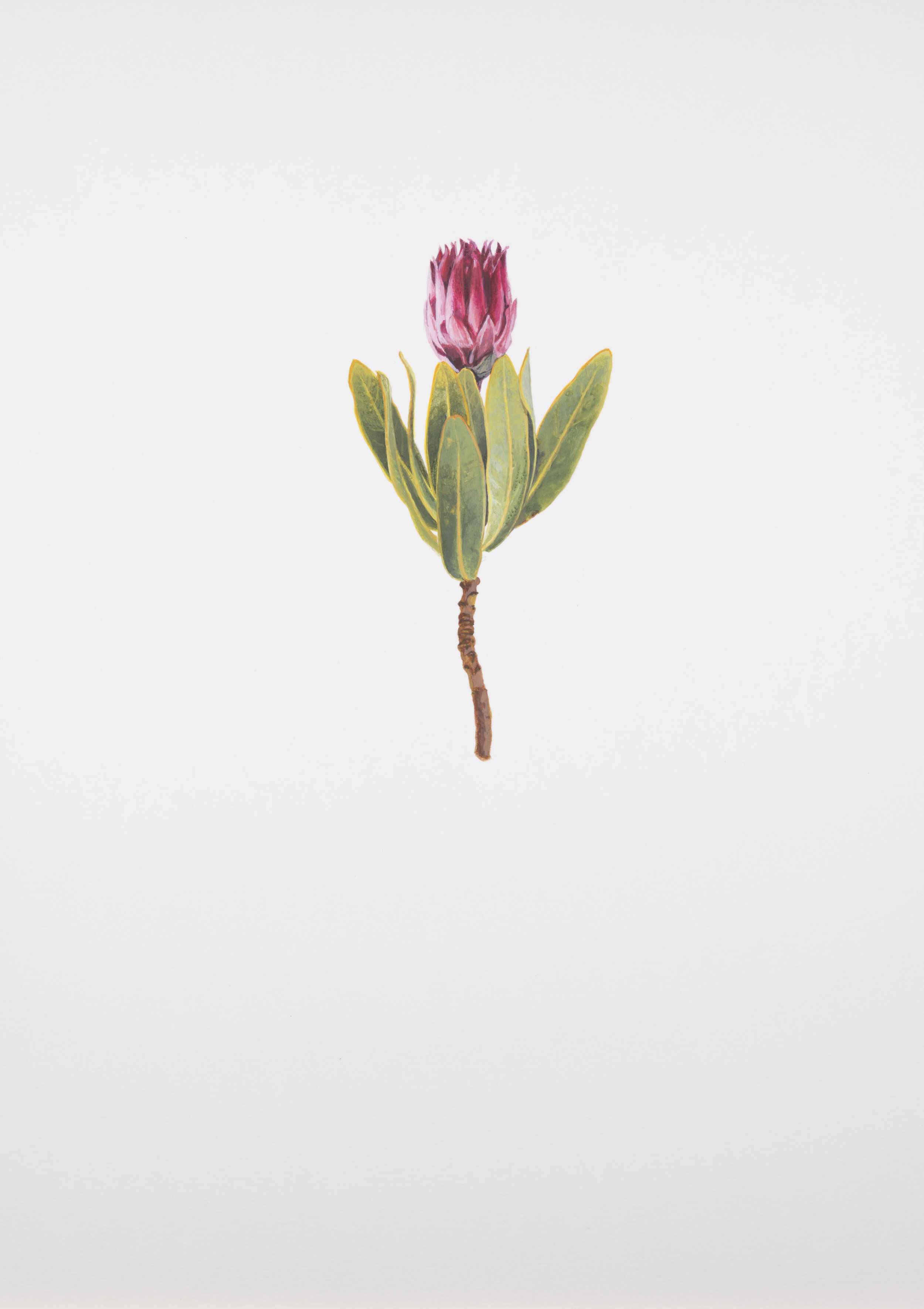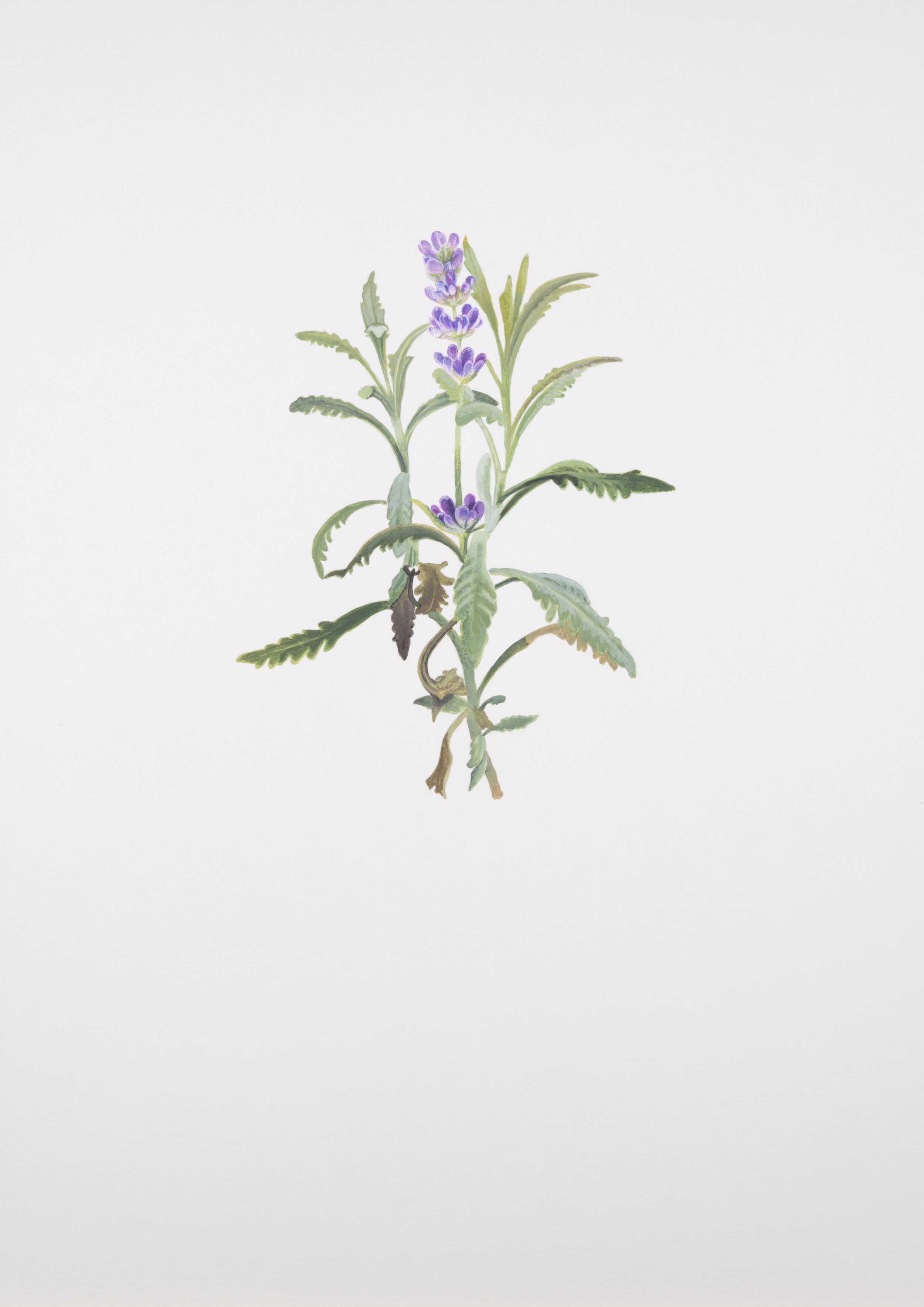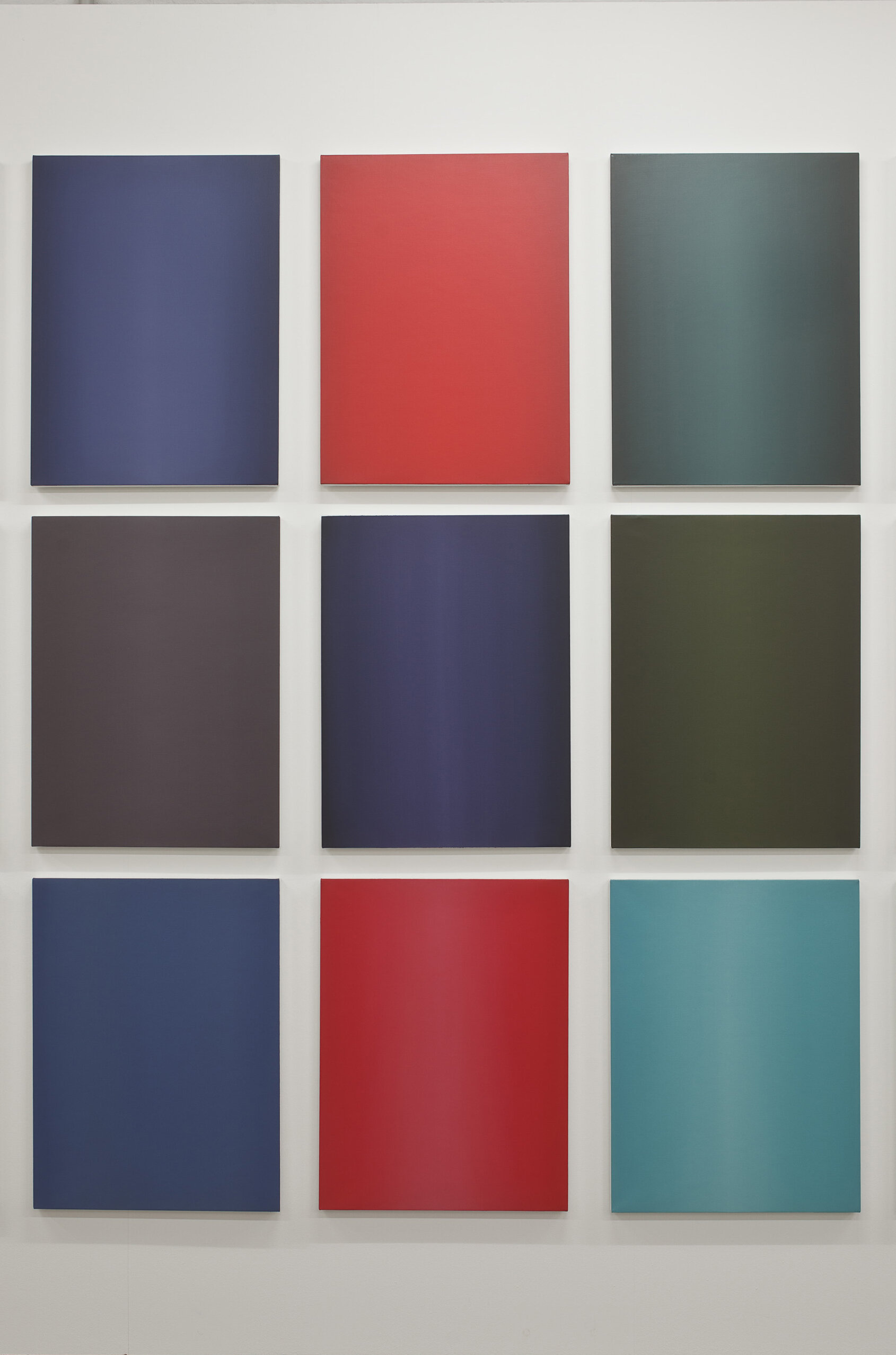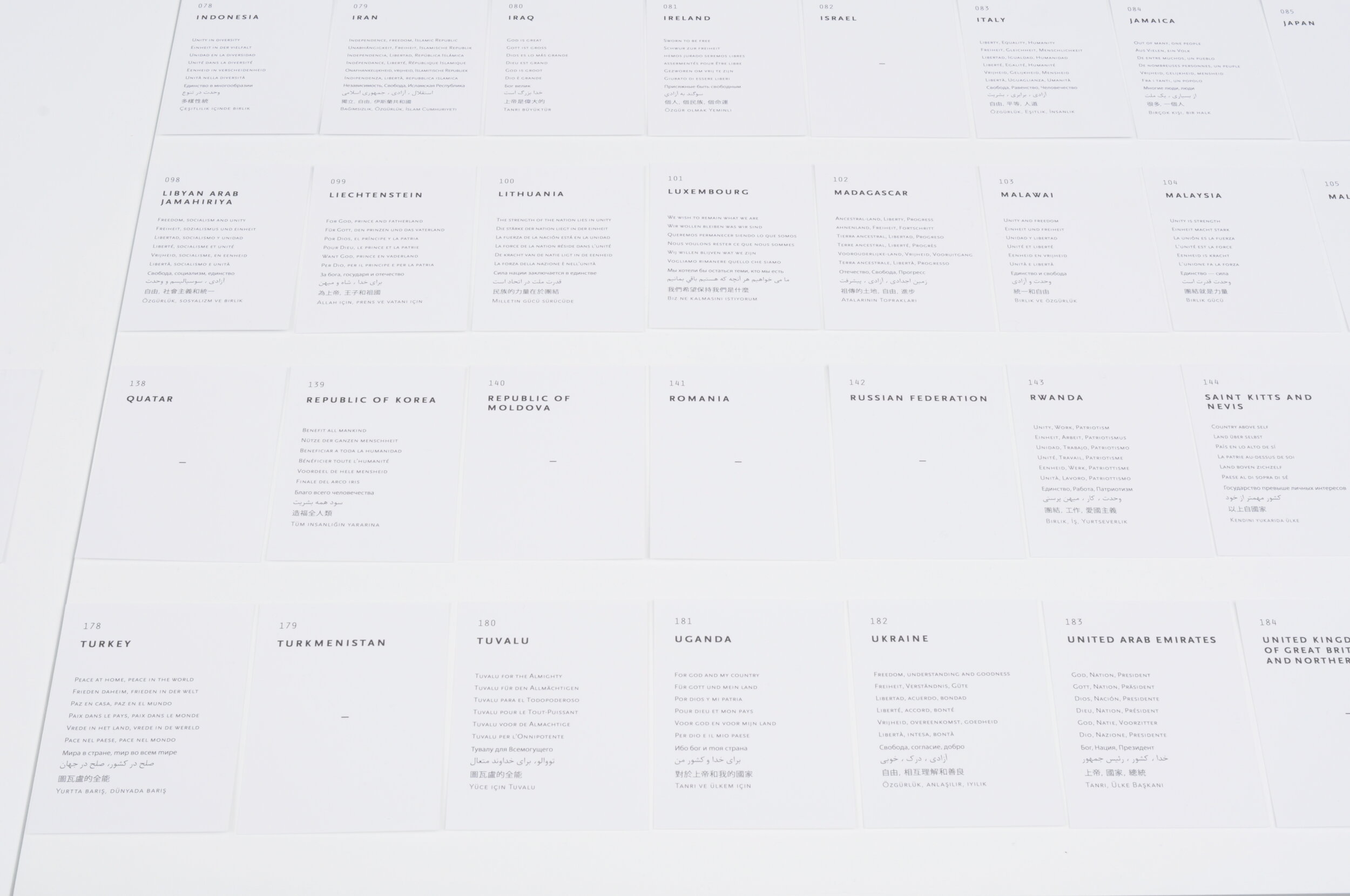2023- 2024
SEVEN SHADES OF BLOOD
When Maryam Najd bids farewell to Tehran in 1992 to enrich her artistic practice in Antwerp with new impulses, she does not leave everything behind. In her art, she retains elements from Iranian miniature art, but also addresses Iranian politics, censorship, and the position of women.
In 2022, Iranian Mahsa Amini dies in her cell after being arrested for improperly wearing her hijab. Her death sparks months of protests. The struggle for women's rights inspires Maryam Najd for the series Nation Wide Protest. The series depicts women's hairstyles on a wig stand. The faces are absent, only the hair reveals their identity.
With her latest series Seven Shades of Blood, Najd takes it a step further. The characteristic hairstyle returns. But the seven hairdos are enclosed in a broad painted border. This border consists of color, abstraction, and geometric shapes. It narrows our focus. It suggests a bay window, a window, or a niche like in Persian miniature art. The wide margin is a boundary; we peek through a keyhole at the mystery and power of the hairstyle.
Thus, the artist paints a contemporary parable. Analogous to Haft Paykar, a Persian epic from the 12th century, the series depicts a cycle in seven colors, from black to white, from Saturday to Friday, across different continents and celestial bodies. Today it is a current female quest for freedom and enlightenment.
Niko Goffin, Art historian and director at Arterie
SATURDAY- Black Dome- India 2023-2024, 130x120 cm- Acrylic paint on canvas
SUNDAY- Yellow Dome- Rūm 2023-2024, 130x120 cm- Acrylic paint on canvas
MONDAY- Green Dome- Khwārazm 2023-2024, 130x120 cm- Acrylic paint on canvas
TUESDAY- Red Dome- Siqlāb 2023-2024, 130x120 cm- Acrylic paint on canvas
WEDNESDAY- Blue Dome- Maghreb 2023-2024, 130x120 cm- Acrylic paint on canvas
THURSDAY- Sandalwood Dome- China 2023-2024, 130x120 cm- Acrylic paint on canvas
FRIDAY- White Dome- Persia 2023-2024, 130x120 cm- Acrylic paint on canvas
2022- 2024
THE COLOUR-BLIND SOCIETY
Today, terms such as “colour-blind society” and “post-racial” are heard throughout the academic world. And yet our societies continue to be plagued by racial injustice. The Colour-blind Society project presents a series of paintings on the theme of racial and gender inequality through cultural hegemony in modern society. It opens a discussion about a new form of slavery by utilizing the socio-cultural manipulations of global powers against ethnic groups or individuals in the neo-colonial era.
The colour-blind society brings together different aspects of critical observation in art. In addition to the methodical invention of different elements – we can mention the combination of figurative representations with abstract geometric patterns or motifs that are national symbols and icons of countries around the world.
Colour-Blind society project, King Protea & The paramour II, 2023- 30x40 cm- Acrylic paint on canvas
Colour-Blind society project, King Protea & The paramour I, 2023- 30x40 cm- Acrylic paint on canvas
Colour-Blind society project, The Butterfly woman 2023-2024, 40x30 cm- Acrylic on canvas
Colour-Blind society project, Woman in White Dress 2023- 30x40 cm- Acrylic paint on canvas
Colour-Blind society project, Woman with the Iron Mask, 2022-2023- 30x40 cm- Acrylic paint on canvas
Colour-Blind society project, Woman with Blue Flower Shoes 2023-2024- 230x 140 cm- Acrylic and Oil paint on canvas
2023
NATION-WIDE PROTEST
2020
GRAND BOUQUET II, from the Botanical National Amalgamation Project
Najd’s recent project Botanical National Amalgamation Project, considers the aesthetics of officialdom for nation states globally. In particular, the project looks at the phenomenon of national flowers – when a nation state selects a botanical species as a symbol or nationality and pride. Typically, the flower is one that is known from nature in the locality. But like much of the nature we experience, many species have migrated or been introduced from elsewhere. Yet the flower, becomes an emblem considered as being rooted to a place, and also a mark of its inner beauty. Grand Bouquet II (2020) takes its inspiration from historical Flemish master Jan Bruegel the Elder, specifically referencing his painting Flowers in a Wooden Vessel (1606 – 1607) depicting a large bouquet of flowers. Najd used Photoshop to incorporate every current national flower into Breugel’s image, of which there are one hundred and twenty-eight in total (not quite every nation has an official flower). The flowers are painted in a photorealist style, which is an approach the artist has developed in her practice over several years. Each individual flower is meticulously rendered in bloom, capturing their natural beauty. Rather than seen in isolation, they form a distinct unity, together perhaps even forming more than the sum of their parts. This unity can be seen as a meditation on a sense of co-dependency of cultures and nations, not just historically, but also under the conditions of globalisation.
Nav Haq, Associate director at the Museum of Contemporary Art Antwerp
2019
BOTANIC: National Amalgamation Project
Najd’s recent project ‘Botanic’ National Amalgamation Project, considers such aesthetics of officialdom for nation states globally. In particular, the project looks at the phenomenon of national flowers – when a nation state selects a botanical species as a symbol or nationality and pride. Typically, the flower is one that is known from nature in the locality. But like much of the nature we experience, many species have migrated or been introduced from elsewhere. Yet the flower, becomes an emblem considered as being rooted to a place, and also a mark of its inner beauty (…)
Botanic National Amalgamation Project consists of three particular components that work together. To set them out into their constituent parts, we could say that the first is a monumental painting, the second is a set of approximately ninety paintings, and the third is a set of interactive cards. The first in the ensemble, the monumental painting, titled Grand Bouquet (2011-2012), takes its inspiration from historical Flemish master Jan Bruegel the Elder (...) The second ensemble of Botanical National Amalgamation Project is a series of individual portraits of a selection of national flowers, with each painting named after the name of the country and the name of the national flower (...) The third work in the ensemble takes a very different form. It is a set of cards that invite our interaction. Each card is double-sided, and there is also once one for every nation. On one side is the national colour of a nation, and on its other side is the national motto of the same nation translated into ten of the most globally-used languages (…)
The term ‘monoculture’ is not just used in the sociological arena, but is also interestingly used in techniques of farming. It is worth noting that the modernistic monoculture approach to nature, particularly of plants and crops in agricultural farming when a single crop is farmed exclusively – leads to greater increase in diseases and build-up of pests. This sits in contrast to the more resistant and self-sufficient qualities that come with bio-diversity and so-called ‘polyculture’. What we can learn from Maryam Najd’s Botanical National Amalgamation Project is that the natural world can be appropriated as a potent symbol for society, in order to argue of the negative effects of monoculture. Isolating plants, including if we talk of flowers, though can leave us with something unambiguous, can ultimately lead to fragility and sickness. For civil society, such resistance to diversity is no different. This brings us back to Najd’s monumental painting, which we can see as creating a representation of polyculture or bio-diversity. Diversity and coexistence is necessary for cultures to thrive, and we must know that hegemonic modernistic structures work against this. There are exponentially more flowers than nations. We must fulfil our obligation in protecting the diversity of nature, and we must also seek once more the autonomy, plurality and connectivity of cultures.
Nav Haq, Associate director at the Museum of Contemporary Art Antwerp
BOTANIC-National Amalgamation project 2019- Installation view at Arthur M. Sackler museum of Art and Archeology Beijing- China
2018
THE AESTHETICS OF SIN
Representations of gender, sexuality, femininity and the woman’s body in particular, not just in mass media, but also in art, remain a divisive area between typical dichotomies of ‘free expression’ and ‘censorship’, historically determined and policed through competing paternalisms(…) Typically working in series, Maryam Najd has made several new paintings for her exhibition titled The Aesthetics of Sin, which follow in this longstanding historical artistic mode of the human nude (...)
The artist has used this series as a way to undertake a personal exercise in making the kind of images that existed outside the parameters of her formative experiences. They might be seen to be asking a subjective question about what ‘sin’ looks like (...)
There is a tension that holds the images; they have a kind of in-between-ness–between figuration and monochrome, between sensuality and restraint. With these paintings, Najd point us towards a grey area, where the typical contentions possess more ambiguity. Perhaps the speculative dimension of art could offer a space of negotiation, rather than one of conflict?
Nav Haq, Associate director at the Museum of Contemporary Art Antwerp
2017
BLOOD STONES- Art in Jette Children's Hospital
2016
Eight Volumes of Fantasy- Groeningemuseum Bruges
An excerpt from a quote by author Morse Peckham ( † 1993) reads that “an organism must grow or change qualitatively”.The sentence from which the excerpt was taken comes from a seminal essay by scholars Mohammad Hussein Oroskhan and Esmaeil Zohdi (2014) and signifies the imaginative journey that the Iranian Romantic poet and painter Sohrab Sepheri ( † 1980) made while writing the poems collected in the Hasht Ketab (Eight Books).
Maryam Najd, an Iranian herself embarked on a journey when she moved from Teheran to Antwerp in the '90's. Since then she has grown as a painter and as an artist, investigating different practices within painting, juxtaposing them in interesting ways. In her exhibition Eight Volumes of Fantasy at the Groeninge Museum in Brugge, the artist took as a basis for her work images of the refugee crisis that circulated in the media the past years and as an inspiration Sepehri's collection of poems, with volume titles such as Green Volume, The Sound of Water Steps or Death of Colors and translated these into constellations of paintings accompanied by selected works from the collection of the museum (...)
Hicham Khalidi, curator and director of Jan van Eyck Academy
2015
“De Stad als Performance” Triennale Brugge
2014
ACCURACY AND BALANCE — WEST
De schilderijen van Maryam Najd ontstaan vanuit een dialectische benadering, zowel qua vorm als qua inhoud. Ze ontwikkelt een hoogst individuele picturale taal die haar oorsprong vindt in twee eeuwenoude culturele tradities: de Perzische en de Westerse. In haar werk roept ze een kritische maar respectvolle dialoog op tussen deze twee werelden. Daartoe combineert ze haar eigen ervaringen met de voorstelling van “realiteit” in de media en ontrafelt ze de anekdotische kracht van het beeld door het te confronteren met het schilderij als het summum van de vrijheid van denken. “Alles draait om het juiste evenwicht,” zo zegt ze zelf. “De confrontatie tussen de wereld waarin ik ben grootgebracht en die waarin ik vandaag leef brengt me regelmatig uit balans, het is in mijn schilderen dat ik beide extremen harmonieus kan samenbrengen.”
Eén van de centrale vragen in haar nieuwste reeks schilderijen is hoe de (naakte) vrouw ge(re)presenteerd wordt in de Westerse wereld. Enerzijds claimt ze emancipatie, vrijheid van expressie en zelfbeschikkingsrecht van het lichaam, anderzijds wordt ze nog steeds tot onderwerp gemaakt van de mannelijke lust – van representatie in de reclame en media tot prostitutie. De ‘vrije’ vrouw deinst er ook zelf niet voor terug om zich te exploiteren als lustobject. Iconen als Madonna, Rihanna, Lady Gaga en Miley Cyrus cultiveren een vrijheid van expressie, maar gebruiken die vrijheid bijna exclusief om op het podium schaars gekleed, seksueel expliciete dansen ten tonele te brengen voor een – vreemd genoeg – vooral vrouwelijk tienerpubliek. Waar ligt de grens tussen vrijheid, erotiek, spel en uitbuiting? En wie bepaalt de grens? Najd velt geen oordeel, ze observeert en onderwerpt deze beeldvorming aan haar schildersoog. De figuratieve doeken waarin Najd deze thematiek verwerkt, zijn subtiel, erotisch, intellectueel en atmosferisch maar ook confronterend, ruw en humoristisch.
Kathleen Weyts, Chief editor and Director GLEAN ART
2014
COMPETING MADONNA
2010—2013
NON—EXISTENCE FLAG PROJECT
This exhibition of new work by Maryam Najd presents a sustained manifestation of the artist’s interest in a world perpetually changing, hiding and dismembering itself in turmoil, fixated on boundaries but which is now more than ever obsessed with overcoming them. Continuing key strands of her work, this new, ambitious project interrogates the symbols and semiotics employed in the formation of national identities. So often exclusive or even reductive, Najd has taken the idea of a country’s flag or national flower and presented the audience with a radical, albeit pleasing, alternative through the aesthetic subtly of her art.
Boundaries and borders so often make up the base of nation states’ flags, but in a globalised world Najd’s magnificent monochrome series Flags is an on-going attempt to visualise a utopian signage that is as intuitive as it is wistful. Methodically going through the world’s flags, Najd has mixed the percentage of colour in each to create a new monochrome palette, creating a bold, daring series of monochromes that offers an invitation to see the world anew. Presented alongside the series is a collection of colour printed cards that can act as a sort of index to these new- world flags. Furthering her investigation into national identity, Najd has employed the mottos of each country on the back side of each card, freeing the often condensed language of these mottos much the same way as her new flags liberate the colour used in national flags.
Employing the dual use of abstraction and figuration for which she was become well known, Najd has once again collapsed the two in a painting of remarkable scope: Grand Bouquet is a painting of various country’s national flowers, arranged into a bouquet that nods to Jan Breughel. This is a work that also features Najd’s trademark wash, the figurative work masked by a layer of white, a distance that belies the not-so-innocent content. This idiosyncratic technique is also seen in older work from 2009-2010 that is on view at Kunstlerhaus Bethanien, Masquerade series, offering a lineage in the work of Najd that shows this pas-de-deux between the figurative and the abstract, the intractable, difficult world and the possibility for the artist to break free from it, apply a concrete individual re-imagination of our troubled realities.
John Holten, Co-founder and Chief editor of Broken Dimanche Press
2009
MASQUERADE SERIES
In 2009, Najd presents a new series of paintings under the title ‘Masquerade’. Within the new series of paintings, the implicit meaning of the veil as a form of hiding, becomes explicit. ‘Masquerade’ groups a series of works that are inspired by the artist’s response to the political situation in Iran and the threat and fear from this current regime.
The series capture Najd’s fascination for the ambivalent purpose of the mask. She contrasts the historical use of the mask as a disguise for theatre and festivals with the practical purpose of inhibiting identification by depicting several forms of veiling. She selected images of protestors using masks to hide their identity during the elections in Iran in 2009. The disguise ranged from the adding of scarves and the use of surgical masks to the use of masks more suitable for fancy dress.
The painting ‘Green Wave Heroes’ reinterprets images found on the internet of protesters in the USA, whereby the ritual and theatrical nature of the mask can be considered as both practical and defensive. By confronting these images with paintings of masks inspired by photographs from Halloween festivity, Najd questions how opposite motifs can be hidden behind a similar disguise.
Najd addresses the influence of our cultural context on the (im)possibility to express our inner desires and thoughts and uses the mask as a metaphor for our need to pass through society safe and unrecognized, avoiding judgments. The series capture Najd’s fascination for the ambivalent purpose of the mask.
Tatjana Pieters, Director Tatjana Pieters gallery
2008-2009
BLOODY BLANKET & BLOODY BLANK
An image becomes a painting therefore; is the image itself no longer important therefore? The source is not revealed. We never know what the subject really was. The media never show us the whole picture either, just what they want. But it is this manipulative aspect, inspired by a ruling ideology, that Najd wants to silence by going beyond the anecdotal aspect of the image and allowing it to speak for itself.
Take the piece ‘Bloody Blanket & Bloody Blank’ (2009): the message in the image is clear, and yet we do not know the location nor the circumstances. There is a lot of white in the image from the blanket and the flash that is emphasized by Najd in order to fade out the information as it were. If you look at ‘Bloody Blanket & Bloody Blank VI’ as well you see that it is based on an image of Lady Di with her lover. But the ‘Lady Di’ aspect, that for other media is the only reason for showing the image, is given no importance in the painting by Najd. The viewer looks at the painting, the composition, the colours, the painting technique; the enigma that is contained in fact in all of Najd’s paintings. The final goal is and remains the painting.
With Najd, this is about blurring reality while painting so that the abstract and figurative interweave. We said earlier that she often uses the reflection of the flash ‘to deform’. When she paints an image, she links it to the ‘painting’ in question and the first layer of significance changes; it is not erased though. She creates an image with an added painted value that is essential for her. Even if there is already figurative representation created in the way she paints (intellectually and manually) she will introduce abstraction into it. This abstraction is not evident in the deforming, in what is left out, but in the many layers, where the colours become blurred and act like a wash if you like over the piece.
The ‘Bloody Blanket’ and ‘Spectacle Trauma’ series are great examples of how Najd consciously tries to achieve this ‘frozen reflection’. She wants to create a balance between war and violence on the one hand and luxury, decadence and glamour on the other. She painted both series in the same tones and colour with the same intensity. The subject is always there, but she tries to express it in such a way that she challenges the media that are the source of these images. So you can’t make them totally abstract. And yet there is a conscious abstraction in her works, because they are inextricably linked to her beliefs about painting.
Marc Ruyters, Chief editor and Owner, <H>ART magazine
2007
GET GIRL, KILL BADDIES, SAVE PLANET: ‘IMAGES FROM THE TV’
The images that Maryam Najd uses are not images you will see around you in everyday reality. They are recorded images of events that disturb and trigger things in us in one way or another. You can see them on the Internet, on TV or other new media, from gruesome to pornographic, melodramatic or simply enigmatic. They form part of the blizzard of images that we are bombarded with every day, with a wave of visual stimuli that are controlled and manipulated by the big media conglomerates. Everyone is served up inescapable truths within the political, ideological and economic (three words that belong in the same bag in fact) context in which they live.
Maryam Najd looks at these images from two different angles: that of her own roots and that of the world she now lives in. They are images that confuse her and touch her emotions.An image on the TV or the Internet is a fraction in time and space. When Maryam Najd photographs an image that she has chosen, the majority of the context in which that image functioned disappears (not all of it course because the memory continues to be present). No matter how she goes about it when she chooses that image and photographs it and then paints it, she changes the medium and the information: it becomes a photo in fact and then finally a painting.
But there is even more to it than that: Najd photographs the TV image in such a way that (a piece of) the machine often appears in the photo and then finally also ends up on the canvas, as a beam, a contour under or around the painted item. And the light of the flash that reflects in the screen of the machine also has an influence on the colours in the painting. Najd sometimes uses that light to brighten colours and at the same time to cloud our view.
An image becomes a painting therefore; is the image itself no longer important therefore? The source is not revealed. We never know what the subject really was. The media never show us the whole picture either, just what they want. But it is this manipulative aspect, inspired by a ruling ideology, that Najd wants to silence by going beyond the anecdotal aspect of the image and allowing it to speak for itself.
Marc Ruyters, Chief editor and owner, <H>ART magazine
